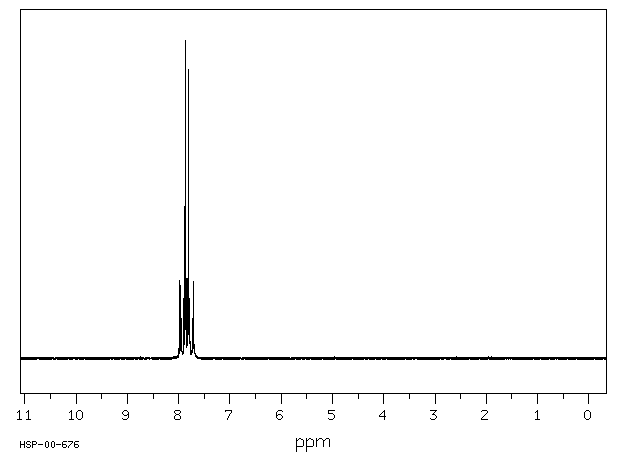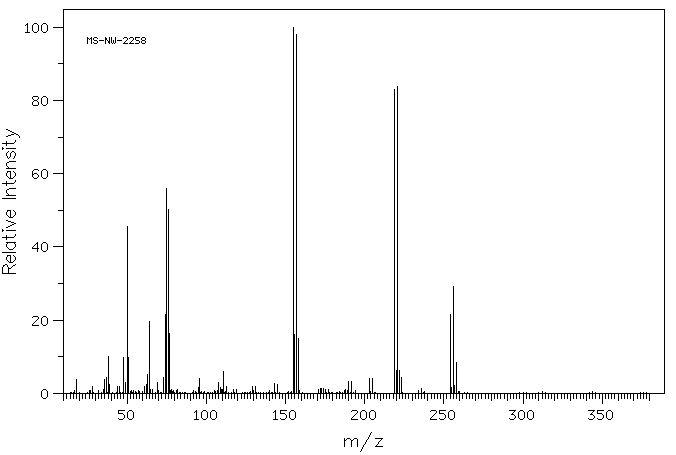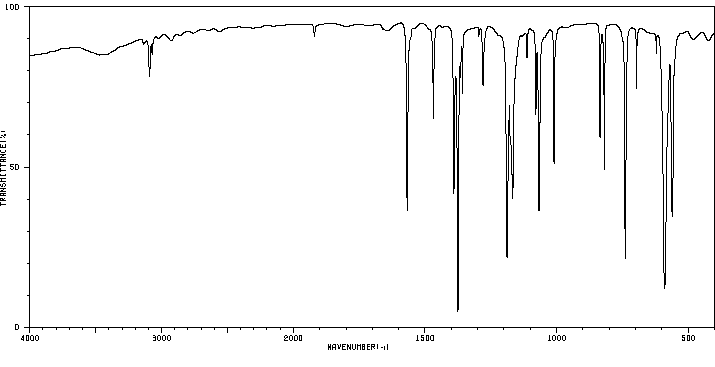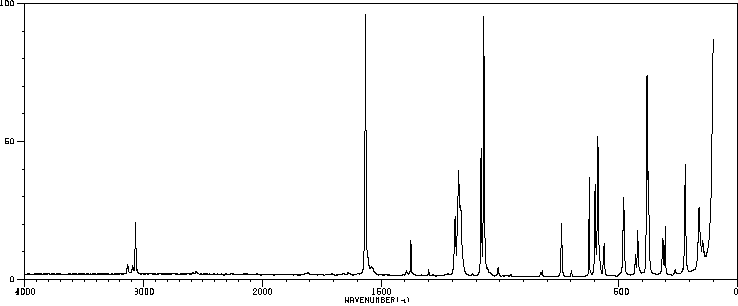4-溴苯磺酰氯 | 98-58-8
中文名称
4-溴苯磺酰氯
中文别名
氯化-4-溴苯磺酰;对溴氯化苯磺酰;对溴苯磺酰氯;4-溴-苯磺酰氯
英文名称
4-bromobenzenesulfonyl chloride
英文别名
p-bromosulfonyl chloride;p-bromobenzenesulfonyl chloride;4-bromobenzene-1-sulfonyl chloride;4-bromobenzensulfonyl chloride
CAS
98-58-8
化学式
C6H4BrClO2S
mdl
MFCD00007437
分子量
255.52
InChiKey
KMMHZIBWCXYAAH-UHFFFAOYSA-N
BEILSTEIN
——
EINECS
——
-
物化性质
-
计算性质
-
ADMET
-
安全信息
-
SDS
-
制备方法与用途
-
上下游信息
-
文献信息
-
表征谱图
-
同类化合物
-
相关功能分类
-
相关结构分类
物化性质
-
熔点:73-75 °C (lit.)
-
沸点:153 °C/15 mmHg (lit.)
-
密度:1.7910 (estimate)
-
闪点:152-154°C/26mm
-
溶解度:溶于氯仿、DMSO
-
稳定性/保质期:
常温常压下不会分解。请避免其接触潮湿空气,并远离强氧化剂、强碱和强酸。
计算性质
-
辛醇/水分配系数(LogP):2.8
-
重原子数:11
-
可旋转键数:1
-
环数:1.0
-
sp3杂化的碳原子比例:0.0
-
拓扑面积:42.5
-
氢给体数:0
-
氢受体数:2
安全信息
-
TSCA:Yes
-
危险等级:8
-
危险品标志:C
-
安全说明:S26,S36/37/39,S45
-
危险类别码:R34
-
WGK Germany:3
-
海关编码:29049020
-
危险品运输编号:UN 3261 8/PG 2
-
危险类别:8
-
包装等级:II
-
危险标志:GHS05
-
危险性描述:H314
-
危险性防范说明:P280,P305 + P351 + P338,P310
-
储存条件:储存于阴凉、干燥、通风良好的库房中。远离火种和热源,并保持容器密封。应将该物质与氧化剂、酸类及碱类分开存放,切忌混储。配备相应种类和数量的消防器材。储存区应备有合适的材料以收集泄漏物。
制备方法与用途
应用
4-溴苯磺酰氯作为一种重要的有机中间体,得到了越来越广泛的应用。它不仅可用于合成血管紧张素ⅡAT1/AT2受体拮抗剂和内皮素受体拮抗剂等具有生物活性的化合物,还在新药研究领域显示出潜在的应用价值。
合成方法将1 mmol硫醇、30% H₂O₂(3 mmol,0.3 mL)和ZrCl₄(1 mmol,0.233 g)的混合物置于5 mL MeCN中,在25°C下搅拌适当时间。反应完成后,通过加入10 mL水骤冷,并用4×5 mL EtOAc萃取。使用无水MgSO₄干燥提取物,并在真空条件下蒸发滤液,最终得到4-溴苯磺酰氯。
用途4-溴苯磺酰氯主要用作农药和医药中间体。
类别有毒物品
可燃性危险特性遇明火可燃;受热分解释放出有毒的溴化物和氮氧化物气体;与水接触时释放毒雾
储运特性应储存在通风良好、低温干燥的库房中,并与其他食品原料及氧化剂分开储存运输。
灭火剂使用二氧化碳、砂土或干粉进行灭火。
上下游信息
-
下游产品
中文名称 英文名称 CAS号 化学式 分子量 —— 4-bromobenzenesulfinyl chloride 75168-73-9 C6H4BrClOS 239.52 —— 4-bromobenzene-1,3-disulfonyl dichloride 117122-41-5 C6H3BrCl2O4S2 354.029 —— 4-bromobenzene-1-sulfonyl iodide 81562-71-2 C6H4BrIO2S 346.971 —— (4-(chlorosulfonyl)phenyl)boronic acid —— C6H6BClO4S 220.441 —— 4-Brom-benzolsulfonylbromid 1950-71-6 C6H4Br2O2S 299.971
反应信息
-
作为反应物:参考文献:名称:Studies in the Sulfone Series. III.1 The Preparation and Properties of 2,8-Diaminothiaxanthone- and 2,8-Thiaxanthene-5-dioxides and Some Related Compounds摘要:DOI:10.1021/ja01200a025
-
作为产物:描述:参考文献:名称:高效 DENV NS2B-NS3 共价抑制剂的鉴定和计算机结合研究摘要:登革热病毒(DENV)是一种节肢动物传播的黄病毒,在过去的几十年里发展迅速,成为世界上分布最广的虫媒病毒。NS2B-NS3 在病毒复制和病毒蛋白成熟中的重要作用使其成为抗 DENV 药物发现的最有希望的靶标。在目前的工作中,通过对已发表的共价抑制剂1 ( IC 50 = 500 nM,k inac / K i = 156.1 M–1 s –1 ),然后进行体外测定。通过共价对接和分子动力学模拟进一步全面的结构-活性关系分析提供了对靶向 NS2B-NS3 的共价抑制剂结合模式的信息理解。DOI:10.1021/acsmedchemlett.1c00653
-
作为试剂:描述:2-硝基苯硫氯 在 吡啶 、 sodium hydroxide 、 4-溴苯磺酰氯 作用下, 以 1,4-二氧六环 为溶剂, 反应 5.33h, 生成 (3S,4R)-3-<<(2-Nitrophenyl)sulfenyl>amino>-4-<(4-nitrophenyl)methyl>-2-oxetanone参考文献:名称:Synthesis, Stability, and Antimicrobial Activity of (+)-Obafluorin and Related .beta.-Lactone Antibiotics摘要:Optically pure obafluorin(l), an antibacterial agent from Pseudomonas fluorescens, was synthesized in six steps via lactonization of N-[(2-nitrophenyl)sulfenyl]-(2S,3R)-2-amino-3-hydroxy-4-(4-nitrophenyl)butanoic acid (12a), which was prepared in a stereospecific manner from 4-nitrophenylacetaldehyde (9a) and (S)-1-benzoyl-2-tert-butyl-3-methyl-4-imidazolidinone (7). A series of analogues was then synthesized in order to probe structural features required for antibacterial activity as well as those responsible for the hydrolytic decomposition of 1 to the corresponding hydroxy acid 23a. Analogues 22b and 22e wherein the nitro group of 1 is replaced with hydrogen and chlorine, respectively, were prepared in a fashion similar to 1, as were the N-acetyl, N-benzoyl, and N-2-(2-aminothiazol-4-yl)-2-(methoxyimino)acetyl (ATMO) derivatives 24a-c. The tosylate salt of L-threonine-beta-lactone (21) was transformed to a series of N-acylated derivatives including the following: 22d (2,3-dihydroxybenzoyl), 25 (2-hydroxybenzoyl), 27 (3,4-dihydroxybenzoyl), 29 (4'methyl-2,2'-bipyridine-4-carbonyl), 31 (epsilon-(L-alpha-aminoadipoyl)), 34 ((N'-2,3-dihydroxybenzoyl)-beta-alanyl), 35 (bromoacetyl), 36 ((6-purinylthio)acetyl), and 37 ((4-pyridylthio)acetyl). The results show that a-amino beta-lactones bearing an N-acyl group with an o- or p-hydroxybenzoyl moiety are especially prone to decomposition under aqueous conditions and that this effect is enhanced by replacement of the 4-nitrobenzyl group on the oxetanone ring of 1 with a methyl. The N-(3,4-dihydroxybenzoyl)L-threonine beta-lactone (27) converts slowly in the solid state to (4S,5S)-2-(3,4-dihydroxybenzoyl)-5-methyl-2-oxazoline-4-carboxylic acid (39b), which hydrolyzes rapidly in 4:1 CD3CN:D2O to O-(3,4-dihydroxybenzoyl)-L-allothreonine (38b). Direct hydrolysis of 27 to 38b under the same conditions has a half-life of 2.4 days. Preliminary assays for antibacterial activity indicate that 29 has nearly comparable activity to obafluorin(l) but is much more stable. The (2-nitrophenyl)sulfenyl p-lactones 14 and 41, as well as the N-(phenylsulfenyl)-L-threonine beta-lactone (44), are the most active agents in the biological assays.DOI:10.1021/jo00092a025
文献信息
-
Cell adhesion-inhibiting antiinflammatory and immune-suppressive compounds申请人:Abbott Laboratories公开号:US20040116518A1公开(公告)日:2004-06-17The present invention relates to novel cinnamide compounds that are useful for treating inflammatory and immune diseases and cerebral vasospasm, to pharmaceutical compositions containing these compounds, and to methods of inhibiting inflammation or suppressing immune response in a mammal.本发明涉及新型肉桂酰胺化合物,用于治疗炎症和免疫性疾病以及脑血管痉挛,以及含有这些化合物的药物组合物,以及在哺乳动物中抑制炎症或抑制免疫反应的方法。
-
Compositions for Treatment of Cystic Fibrosis and Other Chronic Diseases申请人:Vertex Pharmaceuticals Incorporated公开号:US20150231142A1公开(公告)日:2015-08-20The present invention relates to pharmaceutical compositions comprising an inhibitor of epithelial sodium channel activity in combination with at least one ABC Transporter modulator compound of Formula A, Formula B, Formula C, or Formula D. The invention also relates to pharmaceutical formulations thereof, and to methods of using such compositions in the treatment of CFTR mediated diseases, particularly cystic fibrosis using the pharmaceutical combination compositions.
-
The organocatalytic synthesis of perfluorophenylsulfides <i>via</i> the thiolation of trimethyl(perfluorophenyl)silanes and thiosulfonates作者:Jinyun Luo、Muze Lin、Leifang Wu、Zhihua Cai、Lin He、Guangfen DuDOI:10.1039/d1ob01350e日期:——The organic superbase t-Bu-P4-catalyzed direct thiolation of trimethyl(perfluorophenyl)silanes and thiosulfonates was developed. Yields of perfluorophenylsulfides of up to 97% under catalysis of 5 mol% t-Bu-P4 were achieved. This method was shown to provide an efficient way to construct the perfluorophenyl–sulfur bond under mild metal-free reaction conditions.
-
[EN] SULFONYL COMPOUNDS THAT INTERACT WITH GLUCOKINASE REGULATORY PROTEIN<br/>[FR] COMPOSÉS DE SULFONYLE QUI INTERAGISSENT AVEC LA PROTÉINE RÉGULATRICE DE LA GLUCOKINASE申请人:AMGEN INC公开号:WO2013123444A1公开(公告)日:2013-08-22The present invention relates to sulfonyl compounds that interact with glucokinase regulatory protein. In addition, the present invention relates to methods of treating type 2 diabetes, and other diseases and/or conditions where glucokinase regulatory protein is involved using the compounds, or pharmaceutically acceptable salts thereof, and pharmaceutical compositions that contain the compounds, or pharmaceutically acceptable salts thereof.
-
Tetra-arylborate lipophilic anions as targeting groups作者:Kishore K. Gaddale Devanna、Justyna M. Gawel、Tracy A. Prime、Filip Cvetko、Cristiane Benincá、Stuart T. Caldwell、Alexander Negoda、Andrew Harrison、Andrew M. James、Evgeny V. Pavlov、Michael P. Murphy、Richard C. HartleyDOI:10.1039/d0cc07924c日期:——
TPB lipophilic anions deliver cargoes to lysosomes and are excluded from mitochondria.
TPB疏水性阴离子将货物运送到溶酶体,并被排除在线粒体之外。
表征谱图
-
氢谱1HNMR
-
质谱MS
-
碳谱13CNMR
-
红外IR
-
拉曼Raman
-
峰位数据
-
峰位匹配
-
表征信息
同类化合物
(βS)-β-氨基-4-(4-羟基苯氧基)-3,5-二碘苯甲丙醇
(S,S)-邻甲苯基-DIPAMP
(S)-(-)-7'-〔4(S)-(苄基)恶唑-2-基]-7-二(3,5-二-叔丁基苯基)膦基-2,2',3,3'-四氢-1,1-螺二氢茚
(S)-盐酸沙丁胺醇
(S)-3-(叔丁基)-4-(2,6-二甲氧基苯基)-2,3-二氢苯并[d][1,3]氧磷杂环戊二烯
(S)-2,2'-双[双(3,5-三氟甲基苯基)膦基]-4,4',6,6'-四甲氧基联苯
(S)-1-[3,5-双(三氟甲基)苯基]-3-[1-(二甲基氨基)-3-甲基丁烷-2-基]硫脲
(R)富马酸托特罗定
(R)-(-)-盐酸尼古地平
(R)-(-)-4,12-双(二苯基膦基)[2.2]对环芳烷(1,5环辛二烯)铑(I)四氟硼酸盐
(R)-(+)-7-双(3,5-二叔丁基苯基)膦基7''-[((6-甲基吡啶-2-基甲基)氨基]-2,2'',3,3''-四氢-1,1''-螺双茚满
(R)-(+)-7-双(3,5-二叔丁基苯基)膦基7''-[(4-叔丁基吡啶-2-基甲基)氨基]-2,2'',3,3''-四氢-1,1''-螺双茚满
(R)-(+)-7-双(3,5-二叔丁基苯基)膦基7''-[(3-甲基吡啶-2-基甲基)氨基]-2,2'',3,3''-四氢-1,1''-螺双茚满
(R)-(+)-4,7-双(3,5-二-叔丁基苯基)膦基-7“-[(吡啶-2-基甲基)氨基]-2,2”,3,3'-四氢1,1'-螺二茚满
(R)-3-(叔丁基)-4-(2,6-二苯氧基苯基)-2,3-二氢苯并[d][1,3]氧杂磷杂环戊烯
(R)-2-[((二苯基膦基)甲基]吡咯烷
(R)-1-[3,5-双(三氟甲基)苯基]-3-[1-(二甲基氨基)-3-甲基丁烷-2-基]硫脲
(N-(4-甲氧基苯基)-N-甲基-3-(1-哌啶基)丙-2-烯酰胺)
(5-溴-2-羟基苯基)-4-氯苯甲酮
(5-溴-2-氯苯基)(4-羟基苯基)甲酮
(5-氧代-3-苯基-2,5-二氢-1,2,3,4-oxatriazol-3-鎓)
(4S,5R)-4-甲基-5-苯基-1,2,3-氧代噻唑烷-2,2-二氧化物-3-羧酸叔丁酯
(4S,4''S)-2,2''-亚环戊基双[4,5-二氢-4-(苯甲基)恶唑]
(4-溴苯基)-[2-氟-4-[6-[甲基(丙-2-烯基)氨基]己氧基]苯基]甲酮
(4-丁氧基苯甲基)三苯基溴化磷
(3aR,8aR)-(-)-4,4,8,8-四(3,5-二甲基苯基)四氢-2,2-二甲基-6-苯基-1,3-二氧戊环[4,5-e]二恶唑磷
(3aR,6aS)-5-氧代六氢环戊基[c]吡咯-2(1H)-羧酸酯
(2Z)-3-[[(4-氯苯基)氨基]-2-氰基丙烯酸乙酯
(2S,3S,5S)-5-(叔丁氧基甲酰氨基)-2-(N-5-噻唑基-甲氧羰基)氨基-1,6-二苯基-3-羟基己烷
(2S,2''S,3S,3''S)-3,3''-二叔丁基-4,4''-双(2,6-二甲氧基苯基)-2,2'',3,3''-四氢-2,2''-联苯并[d][1,3]氧杂磷杂戊环
(2S)-(-)-2-{[[[[3,5-双(氟代甲基)苯基]氨基]硫代甲基]氨基}-N-(二苯基甲基)-N,3,3-三甲基丁酰胺
(2S)-2-[[[[[((1S,2S)-2-氨基环己基]氨基]硫代甲基]氨基]-N-(二苯甲基)-N,3,3-三甲基丁酰胺
(2S)-2-[[[[[[((1R,2R)-2-氨基环己基]氨基]硫代甲基]氨基]-N-(二苯甲基)-N,3,3-三甲基丁酰胺
(2-硝基苯基)磷酸三酰胺
(2,6-二氯苯基)乙酰氯
(2,3-二甲氧基-5-甲基苯基)硼酸
(1S,2S,3S,5S)-5-叠氮基-3-(苯基甲氧基)-2-[(苯基甲氧基)甲基]环戊醇
(1S,2S,3R,5R)-2-(苄氧基)甲基-6-氧杂双环[3.1.0]己-3-醇
(1-(4-氟苯基)环丙基)甲胺盐酸盐
(1-(3-溴苯基)环丁基)甲胺盐酸盐
(1-(2-氯苯基)环丁基)甲胺盐酸盐
(1-(2-氟苯基)环丙基)甲胺盐酸盐
(1-(2,6-二氟苯基)环丙基)甲胺盐酸盐
(-)-去甲基西布曲明
龙蒿油
龙胆酸钠
龙胆酸叔丁酯
龙胆酸
龙胆紫-d6
龙胆紫











